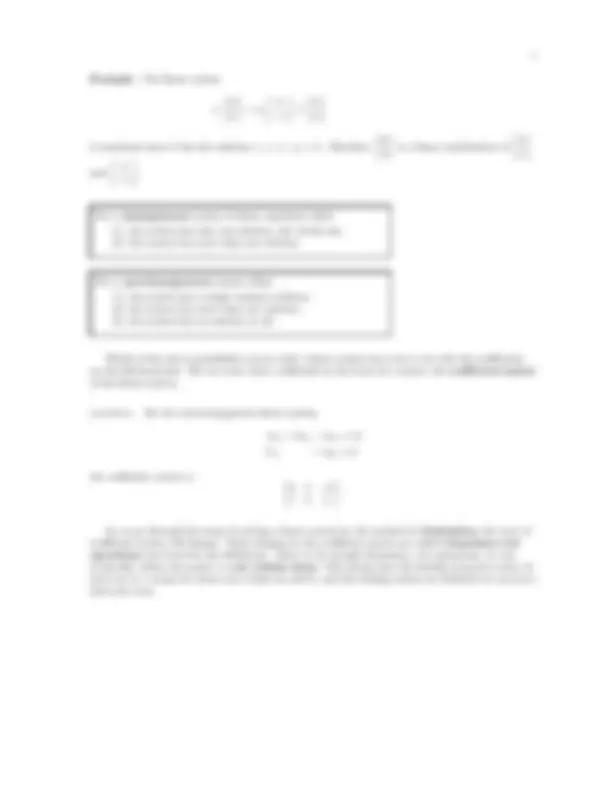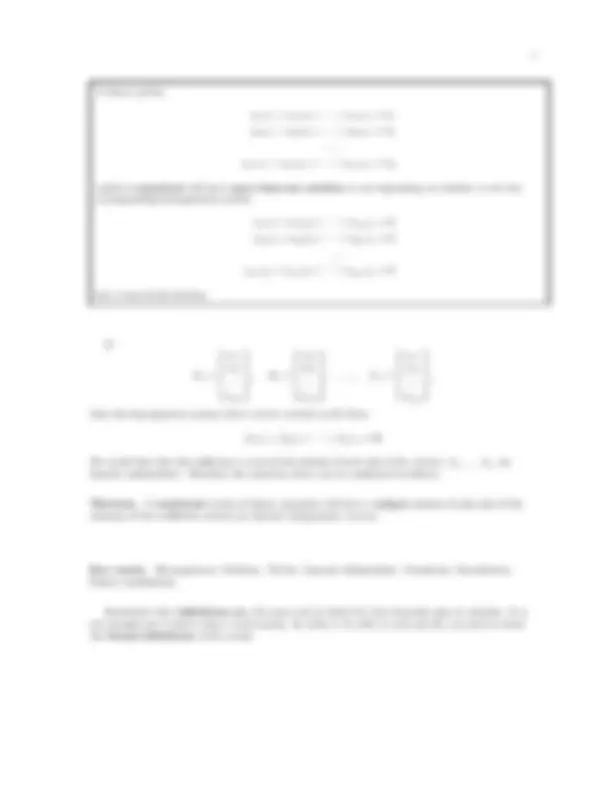





Study with the several resources on Docsity

Earn points by helping other students or get them with a premium plan


Prepare for your exams
Study with the several resources on Docsity

Earn points to download
Earn points by helping other students or get them with a premium plan
Community
Ask the community for help and clear up your study doubts
Discover the best universities in your country according to Docsity users
Free resources
Download our free guides on studying techniques, anxiety management strategies, and thesis advice from Docsity tutors
Material Type: Notes; Class: Calculus III; University: University of Hawaii at Hilo; Term: Unknown 1989;
Typology: Study notes
1 / 5

This page cannot be seen from the preview
Don't miss anything!




Basic Terminology for Systems of Equations in a Nutshell
E. L. Lady
A system of linear equations is something like the following:
3 x 1 − 7 x 2 + 4x 3 = 10 5 x 1 + 8x 2 − 12 x 3 = − 1.
Note that the number of equations is not required to be the same as the number of unknowns.
A solution to this system would be a set of values for x 1 , x 2 , and x 3 which makes the equations true. For instance, x 1 = 3, x 2 = 1, x 3 = 2 is a solution. We will often think of a solution as being a vector: [3, 1 , 2] is a solution to the above equation. (For technical reasons, it will later be better to write solution vectors vertically rather than horizontally. For the moment, we won’t worry about the way vectors are written.)
As you know from Math 231, a system of two equations can also be thought of as a single equation between two-dimensional vectors. It’s easier to see things if we write these vectors vertically. The above system then becomes the vector equation
[ 3 5
x 1 +
x 2 +
x 3 =
A system of linear equations is called homogeneous if the right hand side is the zero vector. For instance
3 x 1 − 7 x 2 + 4x 3 = 0 5 x 1 + 8x 2 − 12 x 3 = 0.
This system actually has a number of solutions, but there is one obvious one, namely
x 1 x 2 x 3
This solution is called the trivial solution. (Important Note: Trivial as used this way in Linear Algebra is a technical term which you need to know.)
Definition. A vector is called trivial if all its coordinates are 0, i. e. if it is the zero vector.
In Linear Algebra we are not interested in only finding one solution to a system of linear equations. We are interested in all possible solutions. In particular, homogeneous systems of equations (see above) are very important. The important question for a homogeneous system is whether or not there is any non-trivial solution, i. e. whether there is any solution other than the trivial one. Sometimes there will be, sometimes there won’t. Paradoxically, it’s actually the case where the trivial solution is the only possible one that is the most important. This situation is described by one of the most important words in the whole course.
Definition. Let v 1 ,... , vn be vectors (all the same dimension). These vectors are called linearly independent if the vector equation
x 1 v 1 + · · · + xnvn = 0
has only the trivial solution.
Example. The vectors
and
are linearly independent.
How can we prove that the above is correct? We look for solutions to the linear system
x 1
which can also be written as
x 1 + 3x 2 = 0 x 1 + 2x 2 = 0.
Subtracting the first equation from the second shows that x 2 = 0 and substitution then shows that x 1 = 0. Therefore the only solution is the trivial one, so the vectors are linearly independent.
Example. The vectors
and
are not linearly independent.
When we try high school algebra on the system
x 1 + 3x 2 = 0 2 x 1 + 6x 2 = 0
it doesn’t work. We are unable to find a single unique solution. In fact, although x 1 = 0 , x 2 = 0 is one solution, there is also another, non-trivial solution x 1 = 3 , x 2 = −1. This non-trivial solution shows that the vectors are not linearly independent.
Going back to non-homogeneous systems. (I. e. the right hand side is not zero.) Unlike homogeneous systems, a non-homogeneous system might not have any solution at all. For instance, the non-homogeneous system
(^) x 1 +
(^) x 2 +
(^) x 3 =
has no solution, since on the left-hand side the third coordinate of each vector is the sum of the first two, but on the right hand side this is not true, so if x 1 , x 2 , and x 3 satisfy the first two equations, they cannot satisfy the third. We then say that this system of equations is inconsistent.
Definition. Let v 1 ,... , vn and b be vectors of the same size, written vertically. The system of linear equations x 1 v 1 + · · · + xnvn = b is called consistent if it has at least one solution and is called inconsistent if it has no solution.
If the system x 1 v 1 + · · · + xnvn = b is consistent, we say that b is a linear combination of v 1 ,... , vn.
example. A matrix in row echelon form:
This would mean that the original linear system has been reduced by elimination to a system looking like
x 2 + 7x 3 + 12x 4 − 2 x 5 = ∗ x 4 − 9 x 5 = ∗ 0 = ∗.
The right hand side of these equations will be derived from the right hand sides of the original system of equations.
Two important points can be noted:
We will see that in fact these are general principles:
A system of linear equations with coefficient matrix A will be inconsistent for certain values on the right hand side if the row echelon form of A contains a row of zeros. If the row echelon form of the coefficient matrix A does not contain a row of zeros, then the system is always consistent, regardless of what the right hand side is.
If every column in the row echelon form of the coefficient matrix contains the leading entry of some row (in other words, if each leading entry is indented exactly one space as you move down the rows), then the linear system will never have more than one solution. On the other hand, if some column does not contain the leading entry for any row, then this variable can be set arbitrarily and consequently if there is any solution at all, there will be infinitely many.
Another way of stating the second principle is that whether a linear system can have more than one solution or not depends on whether the row echelon form of the coefficient matrix has more columns than non-zero rows. (Note that the row echelon form could not possibly have fewer columns than non-zero rows. (why?))
In particular, if the original coefficient matrix has more columns than rows, then the system could never have only one solution. Applied to the homogeneous case, this can be stated as
Theorem 1.12 (p. 59). A homogeneous system of m linear equations in n unknowns always has a non-trivial solution if m < n.
Since the existence of multiple solutions (provided that there is any solution at all) depends only on the coefficient matrix and since a homogeneous system always has at least one solution (namely the trivial one), multiple solutions for a linear system are possible only if the corresponding homogeneous system has multiple solutions. But the homogeneous system has multiple solutions if and only if it has a non-trivial solution. In other words
A linear system
a 11 x 1 + a 12 x 2 + · · · + a 1 nxn = b 1 a 21 x 1 + a 22 x 2 + · · · + a 2 nxn = b 2
... am 1 x 1 + am 2 x 2 + · · · + amnxn = bm
which is consistent will have more than one solution or not depending on whether or not the corresponding homogeneous system
a 11 x 1 + a 12 x 2 + · · · + a 1 nxn = 0 a 21 x 1 + a 22 x 2 + · · · + a 2 nxn = 0
... am 1 x 1 + am 2 x 2 + · · · + amnxn = 0
has a non-trivial solution.
If
a 11 a 21 .. . am 1
a 12 a 22 .. . am 2
,^... ,^ An^ =
a 1 n a 2 n .. . amn
then the homogeneous system above can be written in the form
A 1 x 1 + A 2 x 2 + · · · + Anxn = 0.
We recall that this does not have a non-trivial solution if and only if the vectors A 1 ,... , An are linearly independent. Therefore the assertion above can be rephrased as follows.
Theorem. A consistent system of linear equations will have a unique solution if and only if the columns of the coefficient matrix are linearly independent vectors.
Key words: Homogeneous. Solution. Trivial. Linearly independent. Consistent. Inconsistent. Linear combination.
Remember that definitions play the same role in Math 311 that formulas play in calculus. It is not enough just to know what a word means. In order to be able to write proofs, you need to know the formal definitions of the words.